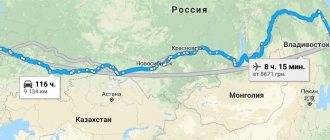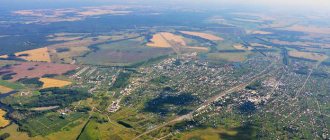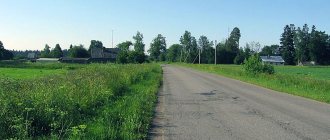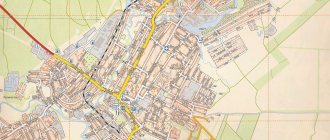Okha
(Sakhalin region)
OKATO code:
64236501
Founded:
1925
Urban settlement since:
1929
City since:
1938 City of regional subordination
Center:
Okha district
Telephone code (reference phone)
| 42437***** |
Deviation from Moscow time, hours:
8
Geographic latitude:
53°35′
Geographic longitude:
142°56′
Altitude above sea level, meters:
30 Sunrise and sunset times in the city of Okha
Map
| Okha: maps |
Okha: photo from space (Google Maps) Okha: photo from space (Microsoft Virtual Earth)
| Oha. Nearest cities. Distances in km. on the map (in brackets along roads) + direction. Using the hyperlink in the distance , you can get the route (information courtesy of the AutoTransInfo website) | |||
| 1 | Nikolaevsk-on-Amur | 153 () | Z |
| 2 | Nogliki | 197 (225) | YU |
| 3 | Bogorodskoye (Khabarovsk Territory) | 214 () | SW |
| 4 | Alexandrovsk-Sakhalinsky | 303 (414) | YU |
| 5 | Tymovskoye | 304 (358) | YU |
a brief description of
The city is located in the north-eastern part of Sakhalin Island, on the coast of Urqt Bay, 402 km from the railway. Nogliki station, 1062 km north of Yuzhno-Sakhalinsk. Connected by railway line with the port of Moskalvo.
Territory (sq. km): 14816
Information about the city of Okha on the Russian Wikipedia site
Historical sketch
In 1880, an oil field was discovered, near which the village of Okhe (later Okha) grew up. However, after several unsuccessful attempts to find oil, the village was abandoned. In the list of populated areas of Sakhalin for 1900, Okha is not listed. In 1908 there was no settlement on this site.
In 1920-25 was occupied by Japan. The first industrial oil was produced in 1921. Many old-timers believe that Okha was founded in 1925. In October 1925, Okha became the center of the Eastern (later Okha) region.
Workers' settlement of Okha from September 23, 1929. City from November 16, 1938.
Name of the city by river Okha; hydronym from Evenk ohe “bad, tasteless”, which is associated with the pollution of the river by oil seeps.
Economy
Okha is a major center of the oil and gas industry of Sakhalin. PA "Sakhalinmorneftegaz". From Okha, oil is supplied via an oil pipeline to Komsomolsk-on-Amur.
CHP.
Factories: mechanical, woodworking, reinforced concrete products and wall materials. Fishery plant, etc.
Main enterprises
THERMAL POWER PLANTS
DAOOT "Okha CHPP"
694460, Sakhalin region, Okha, 3rd km
Offers:
Electric and thermal energy
OIL PRODUCTION INDUSTRY
OJSC "Rosneft-Sakhalinmorneftegaz"
694460, Sakhalin region, Okha, st.
Lenina, 24 Offers:
oil, natural gas, well drilling
BUILDING MATERIALS INDUSTRY
OJSC "Sakhalinmorneftemontazh"
694460, Sakhalin region, Okha, st.
Sovetskaya, 26 Offers:
Construction lime, fine building materials, construction sand, sand-gravel mixture, precast reinforced concrete, ready-mixed concrete
Culture, science, education
Scientific Research and Design Institute "SakhalinNIPImorneft".
Museums, galleries, exhibition halls
Okha Museum of Local Lore 694490, Sakhalin region, Okha, st. Sovetskaya, 1 Phone(s): (42437) 2-24-91
| Population by year (thousands of inhabitants) | |||||||
| 1931 | 7.7 | 1996 | 31.7 | 2008 | 26.4 | 2017 | 20.9 |
| 1939 | 19.6 | 1998 | 29.4 | 2010 | 25.9 | 2018 | 20.7 |
| 1959 | 27.6 | 2000 | 28.2 | 2011 | 23.0 | 2019 | 20.4 |
| 1967 | 30 | 2001 | 28.4 | 2012 | 22.3 | 2020 | 20.0 |
| 1970 | 30.9 | 2003 | 28.0 | 2013 | 21.8 | 2021 | 19.8 |
| 1979 | 32.9 | 2005 | 27.2 | 2014 | 21.5 | ||
| 1989 | 36.1 | 2006 | 26.9 | 2015 | 21.2 | ||
| 1992 | 37 | 2007 | 26.7 | 2016 | 21.1 | ||
Northern capital of Sakhalin
Okha is the northernmost city on Sakhalin. It arose during the Soviet years and was prosperous for a long time, and then began to slowly decline. Oil production “gave birth” to Okha, and now the deposits are being depleted and dragging the northern capital of Sakhalin with them to oblivion. But the city today, despite its small historical age, has its own peculiarity.
“Okha” translated from Nivkh means bad water, dirty river. Indeed, the Okhinka River is still polluted by natural oil seeps. This river flows into Urkt Bay, where there were practically no permanent Aboriginal settlements.
The main livelihood of the indigenous people here is fishing. And although the sea area closest to Okha—Urkt Bay—is located almost within the city limits, it is not the most fishing place.
There is no need to look for a rich historical heritage here. The settlement received city status in 1938, but the first settlements appeared at the end of the 19th century, when oil seeps were discovered here. They still exist almost within the city limits. As before, black gold is pumped here; the deposits have already been fairly depleted, but they have not yet been closed. Evidence of the first fishing can be safely called the Zotov tower, which is located not far from the Okha Thermal Power Plant and is surrounded by modern rocking chairs. The Zotov Tower is the only monument of federal significance in Okha; it was built in 1910. The wooden structure consists of a log house and a tower, whose height is more than 13 meters. These are the structures that were used in the first oil field. A 125-meter well was drilled on this derrick and the first commercial oil was produced. The tower was named after the industrialist Zotov, who tried to find oil here for several seasons in a row, but was unsuccessful. His business was continued by his sons-in-law, and luck smiled upon them, but they failed to develop their success. The tower operated until the 50s of the twentieth century. The oil industry, by and large, began to develop on Sakhalin by the Japanese, who had a concession in Okha. They were mining black gold until 1944, but no traces of the presence of the Japanese remained for a long time.
There is a monument that reminds us of something that also no longer exists in the Okha region. At the end of the last century, the narrow-gauge railway that connected Okha and the port of Moskalvo, as well as the city with the village of Nogliki, was liquidated. In memory of the work of railway workers, a steam locomotive was placed in eternal parking. It is located on a small hill near Vokzalnaya Street. The steam locomotive "PT-4-524" was produced in 1955 and operated until 1987. A year later, it became a monument and a reminder of an industry that no longer exists in the Okha region. Now this time-worn rarity is in a very unsightly condition. But since its shabby appearance, peeling paint, and rust-eaten parts are invisible from the road, they don’t pay much attention to it.
In the first years of oil field development in Okha, wooden houses, mostly barracks, were built. There were also quickly erected round houses, which were called fanzes. One such fanza has survived to this day in the village of Damir. The name of one of the city's districts was given from the abbreviated phrase “Long live the world revolution.”
Now there is practically nothing left of the wooden buildings. In the city center there are several houses built in the 1950s, the so-called Stalin buildings. But their years are numbered: the buildings are considered unsafe and are put on the queue for demolition. It must be said that these houses are not distinguished by anything architecturally outstanding. Among the old buildings, perhaps only the regional Palace of Culture can be distinguished. Almost simultaneously with him, a monument to V.I. was erected in the city. To Lenin - what is a city in Russia without Ilyich? The sculpture was installed in 1954, it is almost 4 meters high and cast from bronze. Its author is the sculptor Dmitry Petrovich Schwartz, who received the Stalin Prize in 1951 for bas-reliefs depicting Lenin-Stalin.
There is a small modest monument in the park nearby in honor of Komsomol members of the 40s. It was installed in 1968, on the half-century anniversary of the Komsomol. When the monument was laid, a capsule was placed in it with an appeal to descendants. They were supposed to get it in 2022, they tried, of course, but... the capsule wasn’t there. Then someone remembered that it seemed to have been taken out earlier so that it would not fall into the hands of vandals.
In the city park there is an obelisk in honor of the 40th anniversary of the liberation of Sakhalin from Japanese militarists. It was installed in 1985.
On Lenin Street there is a monument to Okha soldiers who died during the Great Patriotic War. The memorial consists of two slabs - vertical and horizontal, next to them is a torch in which an eternal flame burns. The monument was erected in 1970, its author is E.I. Veitlin.
Closer to the center, on the same street, there is a monument to the victims of the Neftegorsk tragedy. In 1995, an earthquake destroyed the village of Neftegorsk, killing almost all its residents - 2040 people.
Next to the memorial is the Church of St. Sergius of Radonezh: it is believed that it is also a kind of monument to that catastrophe. Until now, among its parishioners there are people who survived the tragedy, and those who pray for their loved ones who became victims of a natural disaster.
There are also several residential buildings in Okha with paintings that you rarely see. This is not graffiti, but something similar to Soviet visual propaganda. Images can be seen on several residential buildings on Karl Marx Street and on a shopping mall (former cinema).








